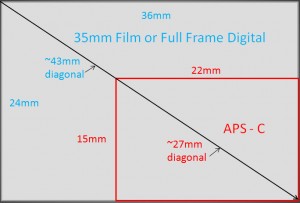When digital SLRs started to come into the market, they essentially replaced the 35mm film camera. In most cases, the lenses that fit your 35mm camera could now be used on the new digitals (from the same manufacturer, of course) without the need for any adapters. Sweet.
Those who made this transition noticed something right away. The 50mm focal length lens that gave a ‘normal’ angle of view on their film camera now acted like an 80mm lens, or slight telephoto, when attached to the digital SLR. In other words, the image was now magnified compared to using the same lens on the 35mm camera.
In some ways this was a benefit, because it meant that the telephoto lens you bought for your 35mm camera now reached a bit further on the digital SLR– about 1.6 times further. The downside was that the wide angle lens that used to work beautifully for landscapes on your 35mm wasn’t so wide anymore on the digital.
 This difference is attributable to the size of the sensor in the digital camera. Most consumer SLRs use an APS-C size sensor, which is 22mm x 15mm. Compare that to 35mm film at 36mm x 24mm. Given the same lens projecting the same ‘image circle’ on the digital sensor and the 35mm negative, the digital sensor only captures part of what the negative captures. Essentially, the digital image is magnified (by 1.6 times) since it’s like zooming in on a small part of the image circle.
This difference is attributable to the size of the sensor in the digital camera. Most consumer SLRs use an APS-C size sensor, which is 22mm x 15mm. Compare that to 35mm film at 36mm x 24mm. Given the same lens projecting the same ‘image circle’ on the digital sensor and the 35mm negative, the digital sensor only captures part of what the negative captures. Essentially, the digital image is magnified (by 1.6 times) since it’s like zooming in on a small part of the image circle.
For years now, professionals who could afford it have been using full frame digital SLRs (example – the Canon 5D) which use a 36mm x 24mm sensor, just like the 35mm negative size. While the manufacturers could have stuffed more pixels into this bigger sensor (and did so to an extent), the big benefit is that they can now make the pixels bigger.
Why? The bigger the pixel, the more light it can gather, meaning the camera will yield less ‘noise’ in the image in low light situations. Overall, the image is cleaner and yes, at a somewhat higher resolution. In fact, Nikon recently introduced the full frame D800 with an astonishing 36 megapixel sensor. Compare that to the Canon 5D’s 22 megapixel resolution or 18 megapixels on most consumer SLRs. Of course, file sizes bloom with higher resolution.
All of this is significant because the prices of full frame camera bodies are starting to slide below the $2000 price point. While APS-C and other similar size sensors kick-started the digital photography revolution, affordable full frames will eventually bring it full circle. The smaller sensors won’t disappear for a while yet, but those of us who came up through the film world will once again be able to shoot the way we used to – only with the immediacy of digital and a moderate size hole in our pocket.
Size Matters – Sensor Talk.